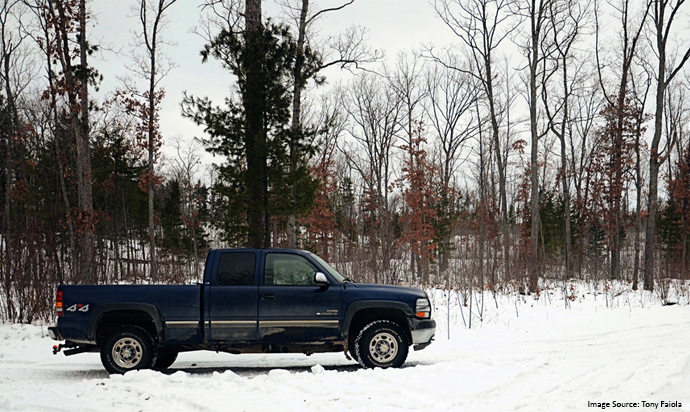The snow and ice in this part of the world can be beautiful, but it can also challenge drivers. In some places in Canada, the snow was flying early. For the rest, we’re getting ahead of the chill and passing along some information and tips about winter driving, from the fuel we use to the tires we drive on.
A different fuel for winter
The first step toward winter driving is done for you at the refineries, replacing summer fuel formulations with a winter variety. This typically begins in September.
Back in 2015, we interviewed an expert about gasoline “volatility, which must be continuously adjusted along with temperature changes to minimize vapour lock, engine stalling and poor operability.”
While winter fuel helps ensure your car starts when you turn the ignition, winter temps do slightly reduce fuel efficiency.
Half a tank
 [Caption: Keep some gas in the tank.]
[Caption: Keep some gas in the tank.]
If you’re running on near-empty, cold temperatures increase the probability that condensation will form in the empty portion of your tank. In this case, your car might not start as easily. Fight the fuel freeze by keeping the tank as full as possible—ideally, at least to the half mark. A full tank is also reassuring in the event that you’re stuck in your car longer than anticipated due to traffic or weather delays.
Keep your charge
Driving an electric vehicle or a hybrid? Have a look at some of these tips to keep the charge for longer throughout the colder months. Like internal combustion engines, electric and hybrid varieties lose efficiency in the winter too, but significantly more than fuel powered vehicles.
Tires
 [ Caption: The snowflake in a mountain is printed directly on the product. It identifies winter tires that meet stringent standards.]
[ Caption: The snowflake in a mountain is printed directly on the product. It identifies winter tires that meet stringent standards.]
When it comes to winter driving in most parts of Canada, winter tires are single-handedly the best way to improve overall safety in snowy and icy conditions.
Charles Renny of the Canadian Automotive Journalists Association told us in a previous post that “the reason for the difference is that the rubber gets hard at different temperatures, and the winter tire will operate better at colder temperatures.” Winter tires are generally made of a softer rubber than summer tires.
Emergency Preparedness
An emergency kit is important all year, but it takes on a special significance as the mercury dips.
 [Caption: The Government of Canada recommends retaining these 17 items in your vehicle, just in case.]
[Caption: The Government of Canada recommends retaining these 17 items in your vehicle, just in case.]
Driving technique
Winter driving is special driving. Canada Safety council publishes safety tips on its website: drive smoothly and slowly, don’t tailgate, brake before turning, learn how to control skids, keep lights on, avoid cruise control, don’t pump brakes, and pay attention. If you’ve never driven in Canada before, you might benefit from a winter driving course from your local driving school.
But, whatever you do, don’t forget to give yourself travel time, stay calm and remember to try and appreciate the beauty in ‘Old Man Winter’.
Related
Cold weather tips for electric vehicles and hybrids
Canadian Fuels Association Blog November 2016
How refineries make fuels right for winter driving
Canadian Fuels Association Blog November 2015
TRANSCAER reaches out to communities with safety training
Canadian Fuels Association Blog October 2017


